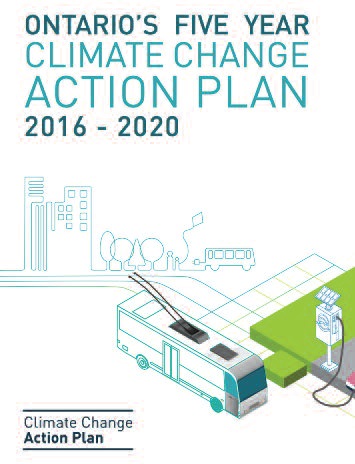STAFF WRITER
– The Ontario Construction Report
How much impact will Ontario’s $8.3 billion Climate Change Action Plan have on the province’s construction industry?
The answer, industry leaders indicate, is it will create opportunities and result in some additional (mostly indirect) costs, but it is too early to assess its full impact because many details still need to be outlined in specific actions.
The action plan commits to lowering greenhouse gas emissions by 15 per cent by 2020, 37 per cent by 2030 and 80 per cent by 2050, and includes 76 distinct initiatives.
The government’s proposal to “provide people and businesses with tools and in – centives to accelerate the use of clean technology that exists today” includes (a) greenhouse gas cap and trade program, building code changes to reduce the fossil fuels in business, and land use planning to “support-low carbon communities,” a provincial announcement said.
Homebuilders and renovators will experience significant changes and – especially for renovators – may discover potentially lucrative energy savings retrofitting opportunities.
The Ontario Home Builders Association (OHBA), in a statement, observed that building code changes “with long-term energy efficiency targets for new net zero carbon emission small buildings by 2030” will only impact a tiny percentage of the overall building stock, and the government should consider the cost/benefits in achieving this standard.
However, the homebuilders generally support the initiative, observing a half dozen new measures affecting their sector, including:
• Home Energy Rating and Disclosure (HERD): Energy audits would be required before a new or existing singlefamily home can be listed for sale, and the energy rating will be included in the real estate listing. These audits are intended to be provided free of charge under this plan.
• A rebate for high-performance: Rebates will go to individuals who purchase or build their own near net zero carbon emission homes, with energy efficiency performance that sufficiently exceeds the requirements of the Building Code.
• Funding for new technologies for homes: Assistance to homeowners to purchase and install low-carbon energy technologies such as geothermal heat pumps and air-source heat pumps, solar thermal and solar energy generation systems.
• Retrofitting existing private apartments: Incentives to install energy efficient technologies, like boiler replacements, adaptive thermostats and lighting retrofits.
• Electric Vehicle Ready Homes: Require all new homes with garages to be constructed with a 50-amp, 240-volt receptacle.
“OHBA has been a longtime supporter of a home energy rating system for existing homes as well as a consumer rebate for newly constructed homes that exceed the Ontario Building Code. We are encouraged that both these recommendations are included in Ontario’s Climate Change Action Plan,” said OHBA CEO Joe Vaccaro.
“When the 2017 Building Code comes into effect in January 2017, houses constructed after that point will consume only 50 per cent of the energy they would have used in 2005,” the OHBA said in a statement. “The Building Code primarily deals with new construction, which comprises only one per cent of the overall building stock on an annual basis, that’s why it is essential to improve the existing 4.8 million homes in Ontario.”
Achieving a 2030 net zero Building Code will require extensive consultation with the industry and the necessary costbenefit analysis for consumers. “With over 30 per cent of Ontario’s new homes being Energy Star qualified, OHBA members are already leaders in building high-performance homes,” said Vaccaro. “We need to ensure that the upgrades we make to the 2030 Building Code are worth it to the consumer.”
Residential and commercial builders will need to deal with changes in land use planning, according to the action plan, to “support low-carbon communities.”
Changes include requiring electric vehicle charging in surface lots, allowing municipalities to pass “bylaws related to green standards in areas other than building construction,” include climate change in official plans, and eliminate minimum parking requirements in municipal zoning bylaws.
Meanwhile in the non-residential sector, David Frame, director of government relations for the Ontario General Contractors Association (OGCA), says it is too early to know the full impact on the industry. “You don’t really know from announcements; you don’t really know until the programs are rolled out,” he said.
Frame says the OGCA has assessed the implications of the cap and trade regime, proclaimed into law this spring and included in the action plan (due to take effect next January 1) and concluded that the construction industry won’t experience direct consequences.
“Most Ontario construction companies won’t be covered because they don’t operate in places like quarries or processing facilities that emit 25,000 tons of greenhouse gas emissions per year or more,” Frame said in a published interview, confirmed in an email to OCR. “But we tend to be purchasing materials from those who do, so certainly the cap and trade cost will be passed onto us and passed on to our buyers.”
On the other side of the business equation, retrofitting and other incentives in the action plan will create work for OGCA members, Frame said.








